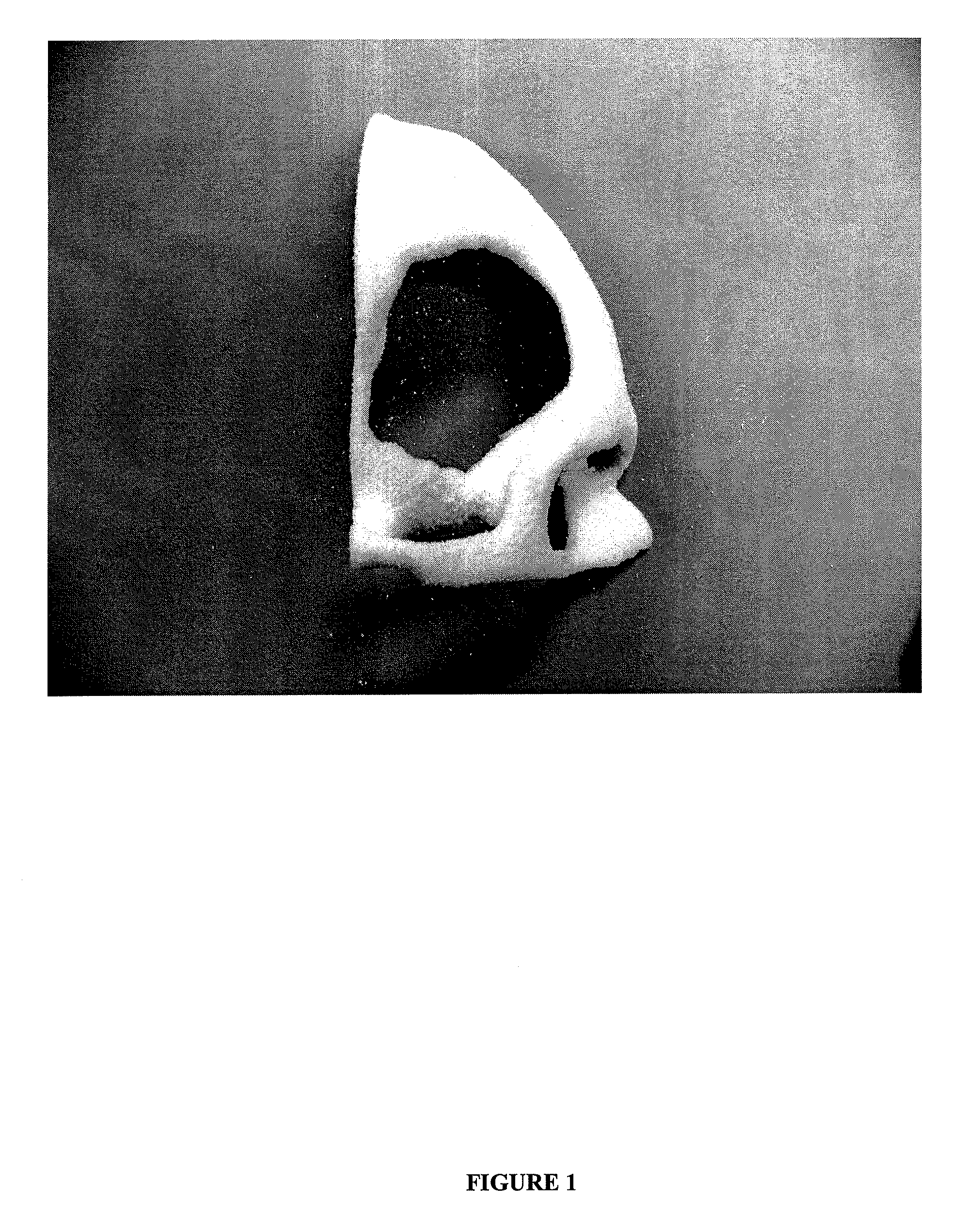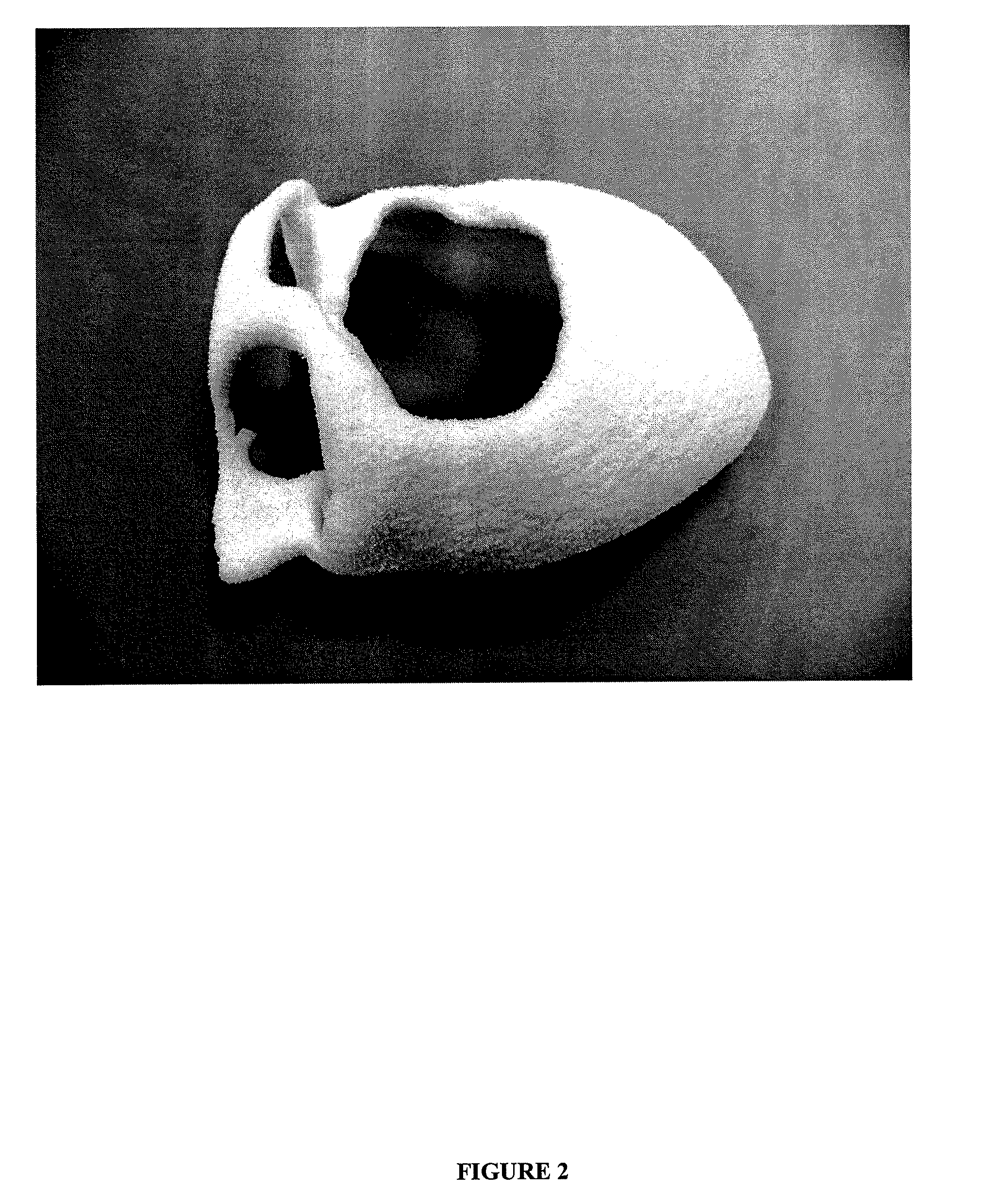Porous laser sintered articles
a technology of porous polymeric materials and lasers, which is applied in the field of sintered polymeric materials, can solve the problems of high melt flow indices and unsuitable porous structure production, and reduce the quality of articles
- Summary
- Abstract
- Description
- Claims
- Application Information
AI Technical Summary
Benefits of technology
Problems solved by technology
Method used
Image
Examples
example 1
Preparation of a Selectively Laser Sintered Porous Polymeric Implant
[0087]A laser sintering apparatus model number EOSINT P 385 from EOS GmbH was used to fabricate the laser sintered porous polymeric implant. A computer file encoding an image of a quarter of a human skull was transferred to the processing unit of the EOS selective laser sintering apparatus. HDPE particles having an average size of about 500 μm and a melt flow index of 2 g per 10 minutes under a 21.6 kg load at 190° C. were loaded into the sample powder chamber of the laser sintering apparatus. The polyethylene particles were pre-heated to about 70° C. in the sample chamber in an argon atmosphere. The sintering chamber was heated to a temperature of about 120° C. and pre-loaded with a layer of polyethylene particles having a thickness of about 1 cm. The sintering chamber was lowered down 600 μm. A first layer of polyethylene particles from the sample chamber was applied to the sintering chamber, the first layer of po...
example 2
Preparation of a Selectively Laser Sintered Porous Polymeric Implant
[0090]A laser sintering apparatus model number EOSINT P 385 from EOS GmbH is used to fabricate the laser sintered porous polymeric implant. A computer file encoding an image of a quarter of a human skull is transferred to the processing unit of the EOS selective laser sintering apparatus. A powder mixture comprising 90 weight percent HDPE particles having an average size of about 500 μm and a melt flow index of 2 g per 10 minutes under a 21.6 kg load at 190° C. and 10 weight percent hydroxyapatite particles (BABI-HAP-G10) is loaded into the sample powder chamber of the laser sintering apparatus. The particulate mixture is pre-heated to about 70° C. in the sample chamber in an argon atmosphere. The sintering chamber is heated to a temperature of about 120° C. and pre-loaded with a layer of polyethylene particles having a thickness of about 1 cm. The sintering chamber is lowered down 600 μm. A first layer of the parti...
example 3
Preparation of a Selectively Laser Sintered Porous Polymeric Implant Having a Porosity Gradient
[0093]A laser sintering apparatus model number EOSINT P 385 from EOS GmbH is used to fabricate the laser sintered porous polymeric implant. A computer file encoding an image of a quarter of a human skull is transferred to the processing unit of the EOS selective laser sintering apparatus. HDPE particles having an average size of about 500 μm and a melt flow index of 2 g per 10 minutes under a 21.6 kg load at 190° C. are loaded into the sample powder chamber of the laser sintering apparatus. The polyethylene particles are pre-heated to about 70° C. in the sample chamber in an argon atmosphere. The sintering chamber is heated to a temperature of about 120° C. and is pre-loaded with a layer of polyethylene particles having a thickness of about 1 cm. The sintering chamber is lowered down 600 μm. A first layer of polyethylene particles is applied to the sintering chamber, the first layer of pol...
PUM
| Property | Measurement | Unit |
|---|---|---|
| porosity | aaaaa | aaaaa |
| pore size | aaaaa | aaaaa |
| pore size | aaaaa | aaaaa |
Abstract
Description
Claims
Application Information
 Login to View More
Login to View More - R&D
- Intellectual Property
- Life Sciences
- Materials
- Tech Scout
- Unparalleled Data Quality
- Higher Quality Content
- 60% Fewer Hallucinations
Browse by: Latest US Patents, China's latest patents, Technical Efficacy Thesaurus, Application Domain, Technology Topic, Popular Technical Reports.
© 2025 PatSnap. All rights reserved.Legal|Privacy policy|Modern Slavery Act Transparency Statement|Sitemap|About US| Contact US: help@patsnap.com



